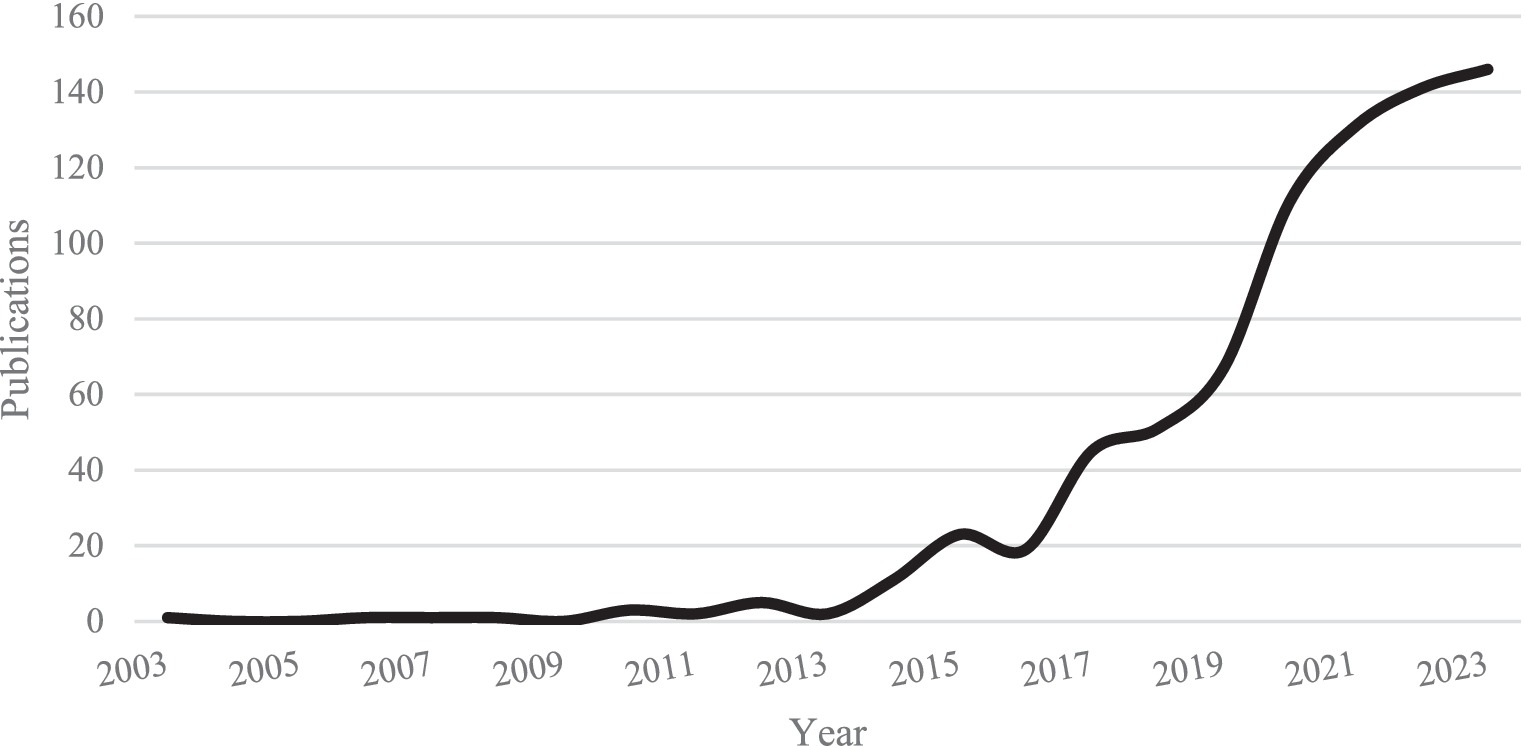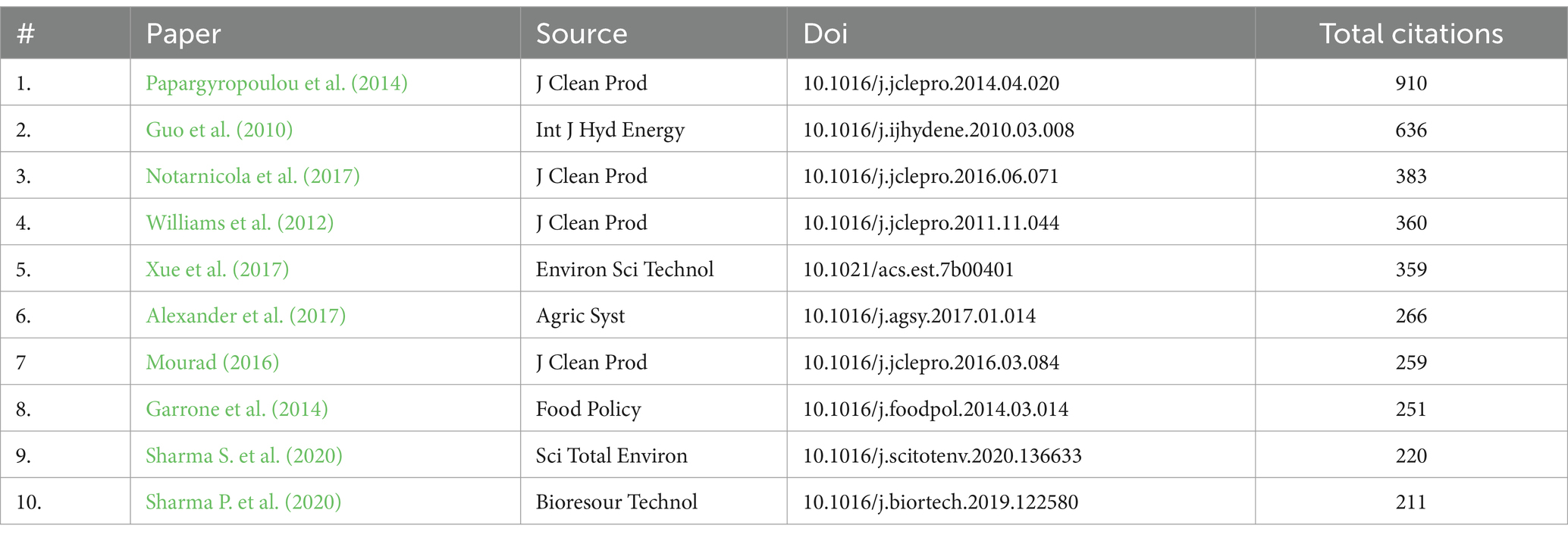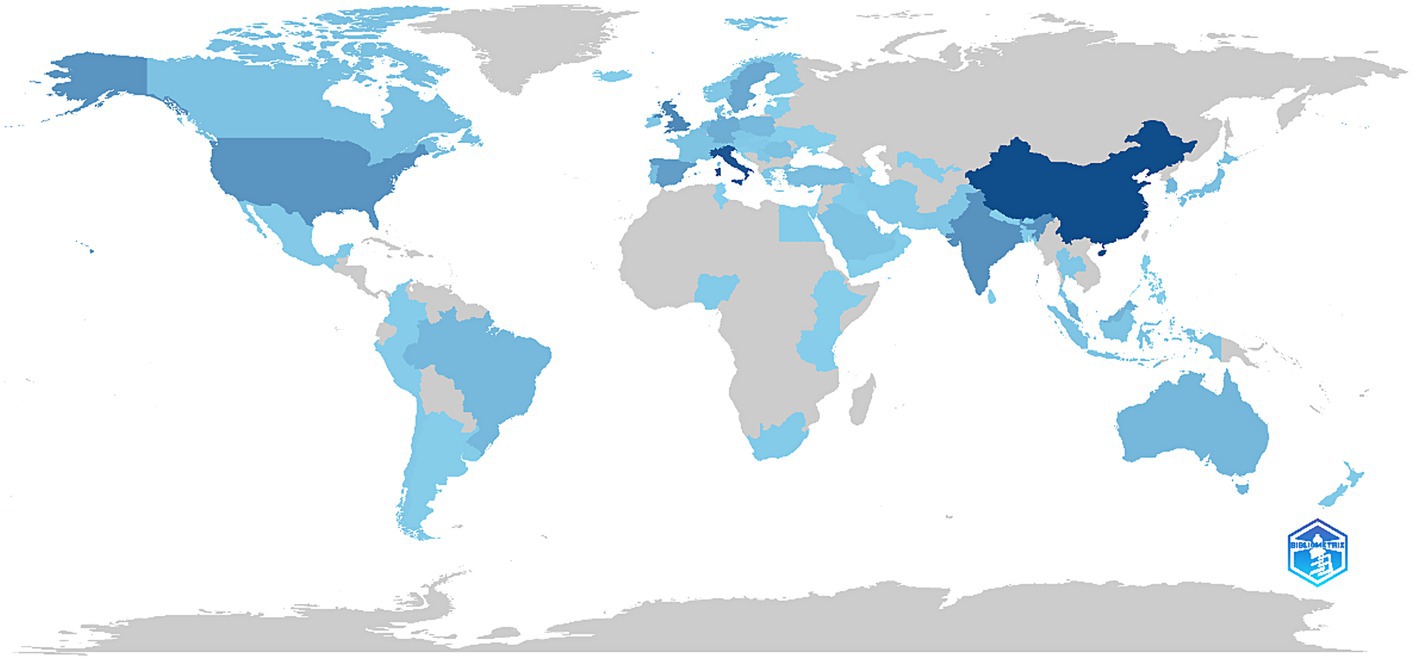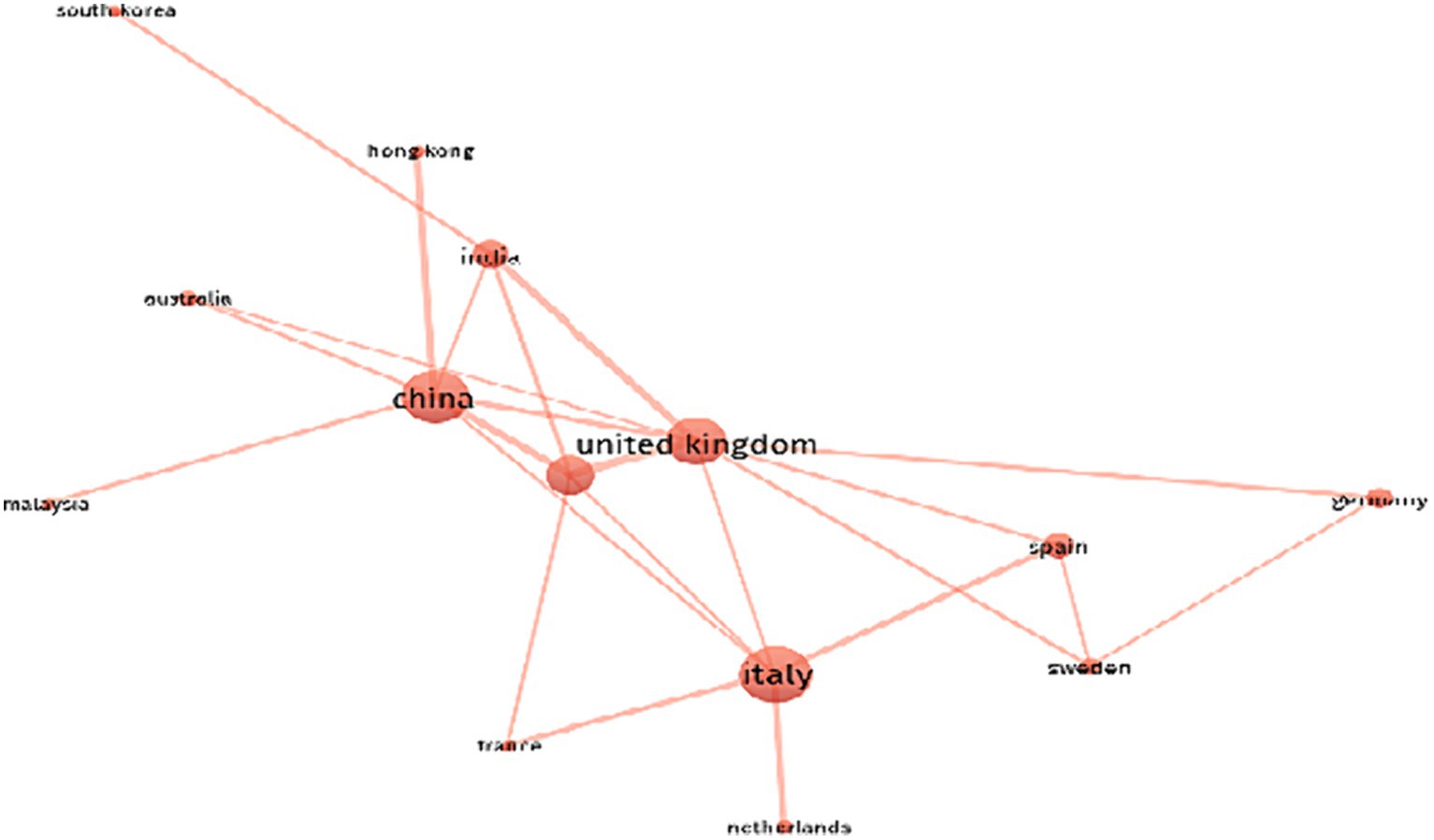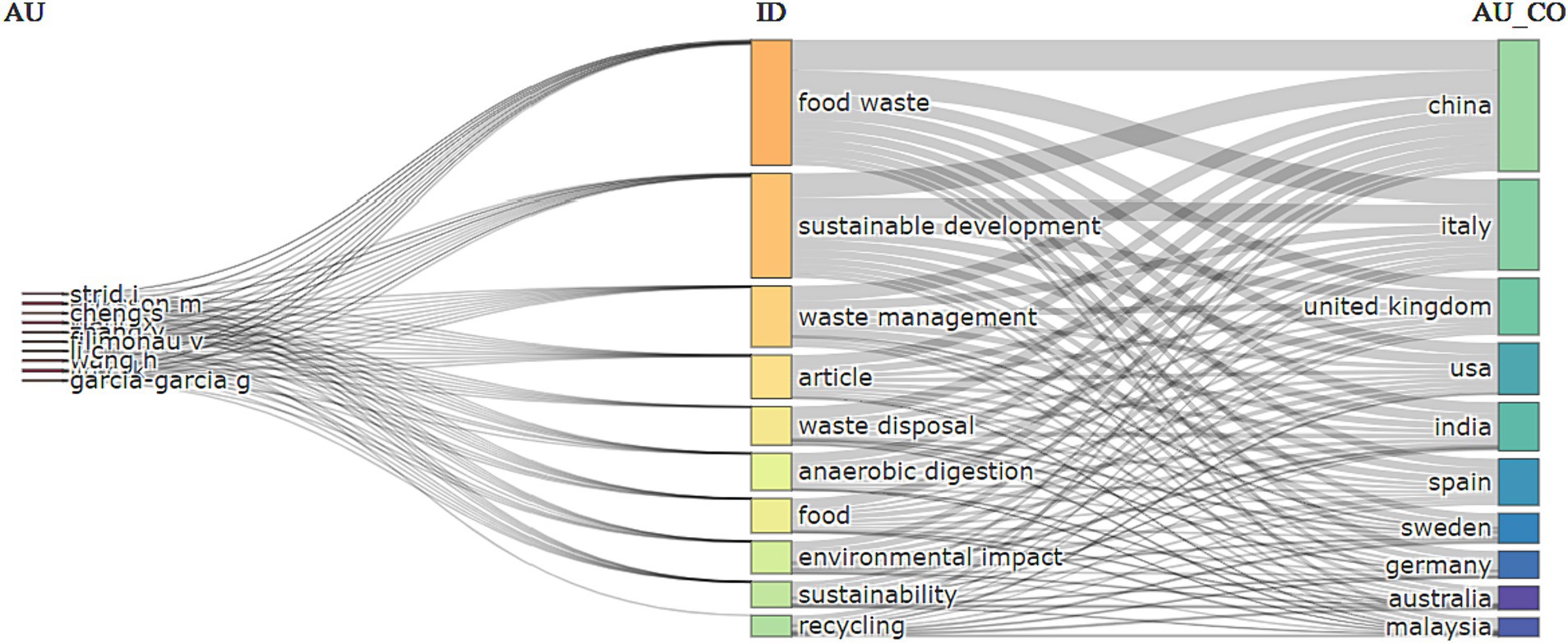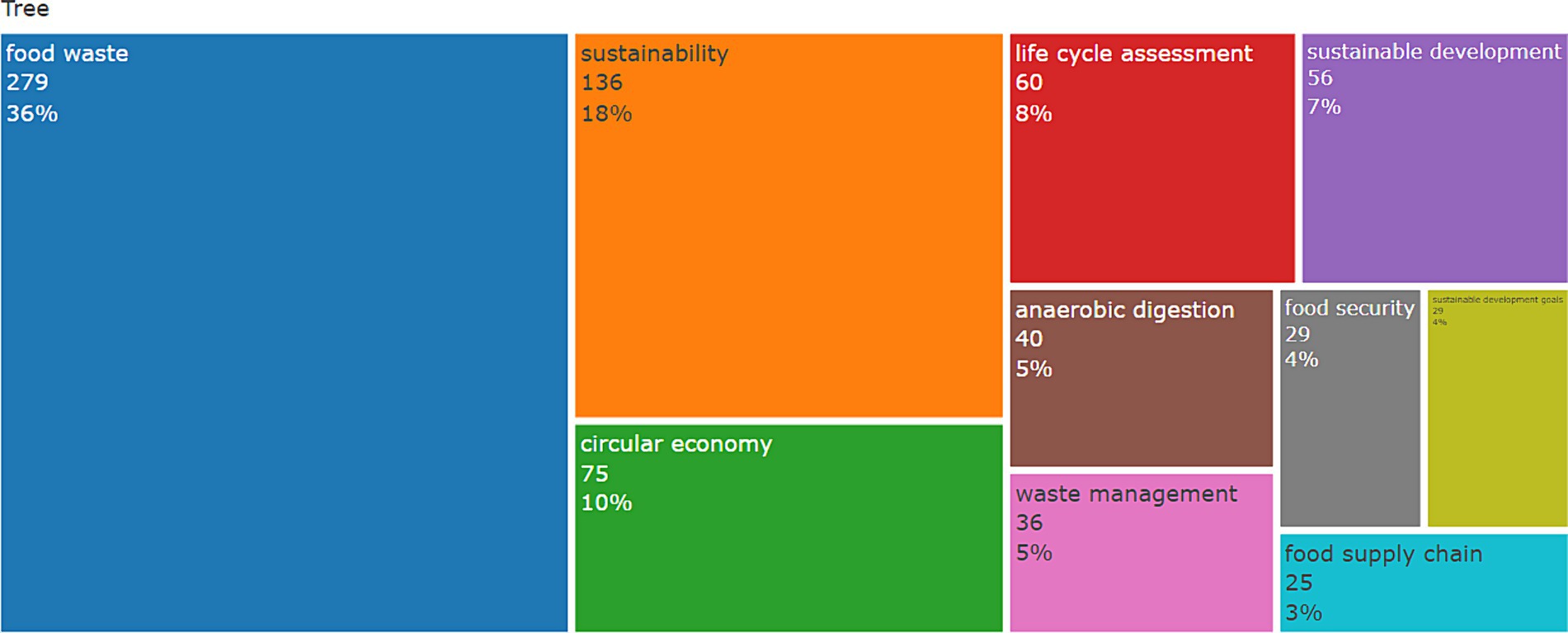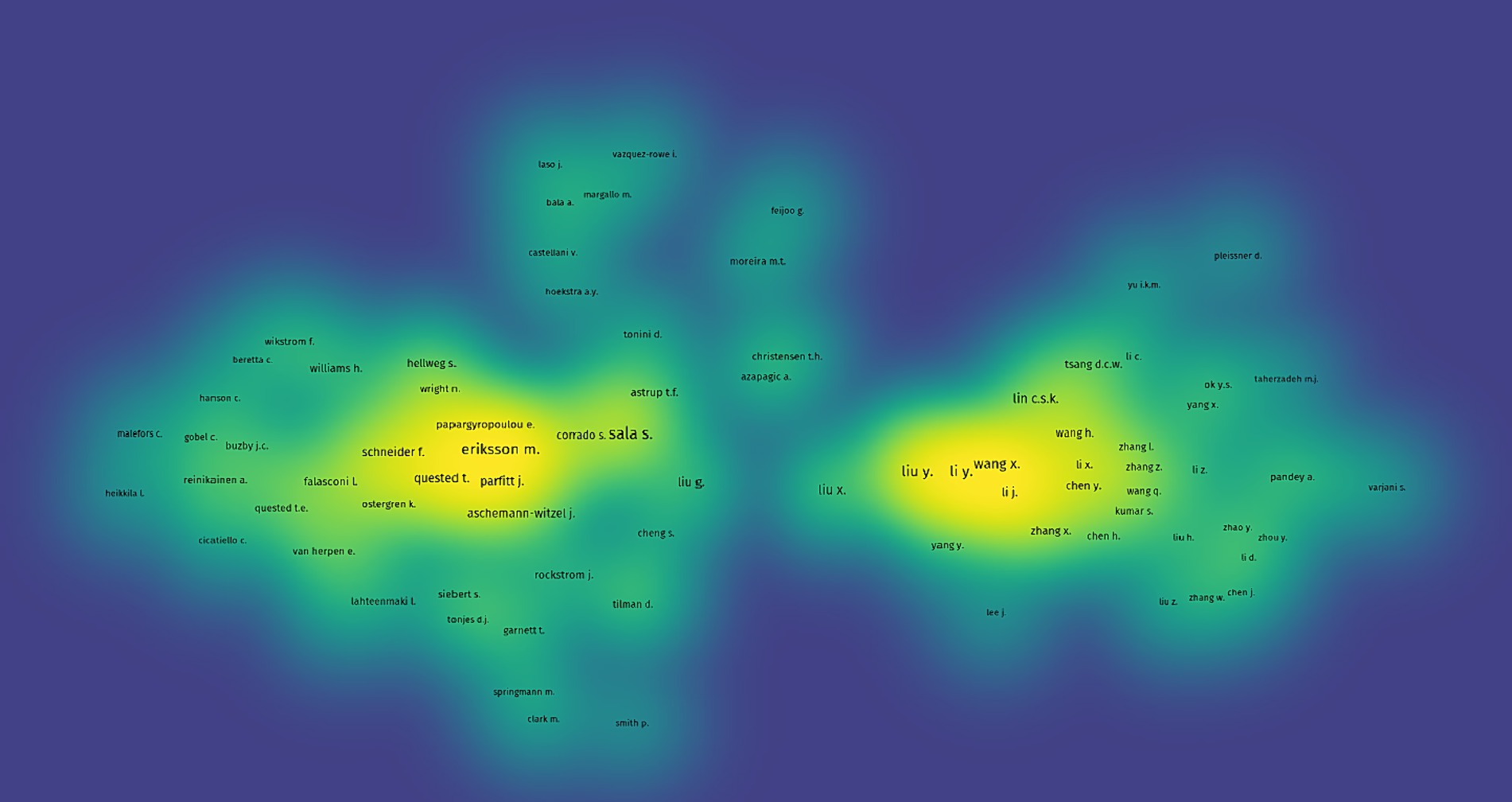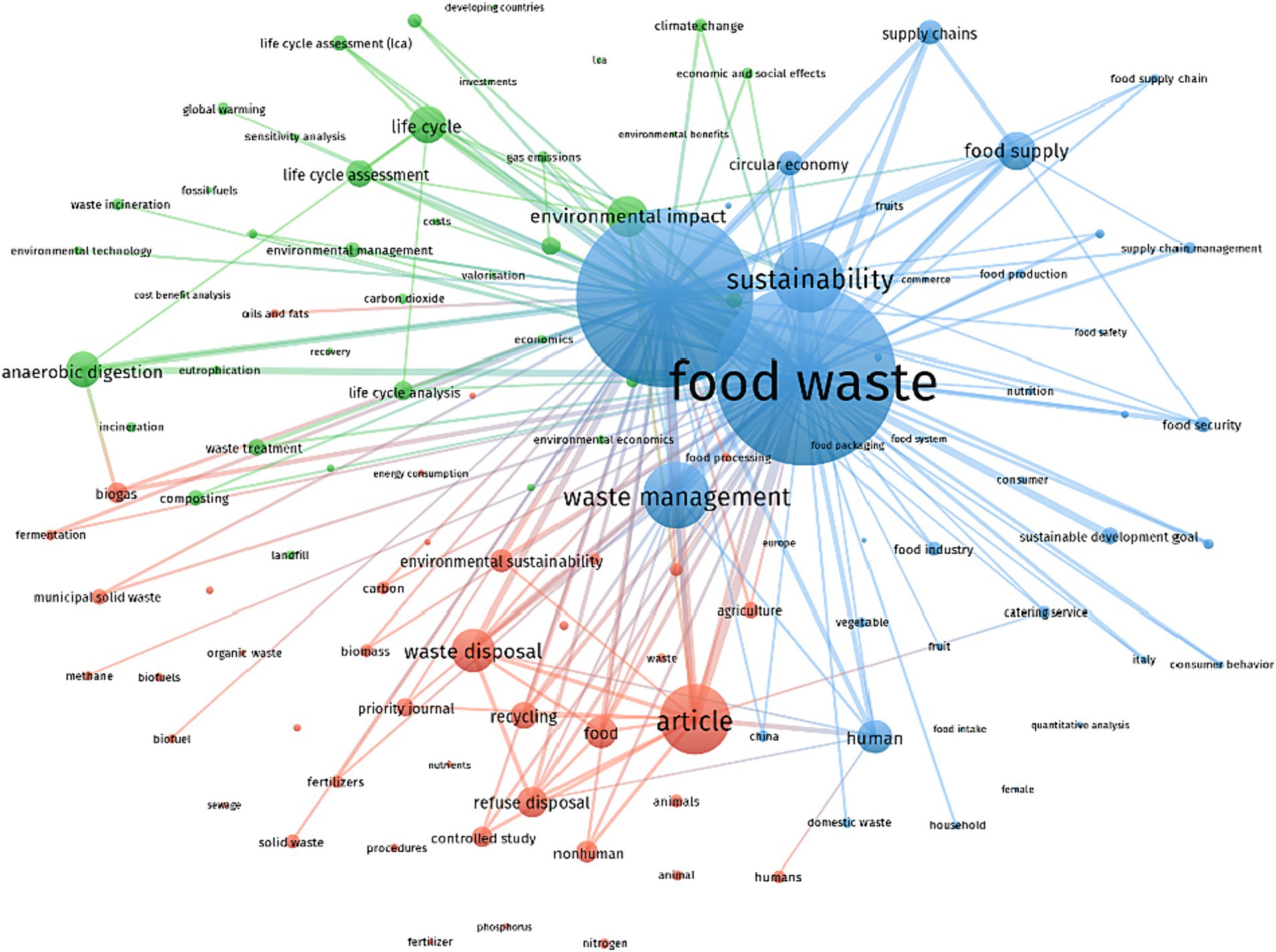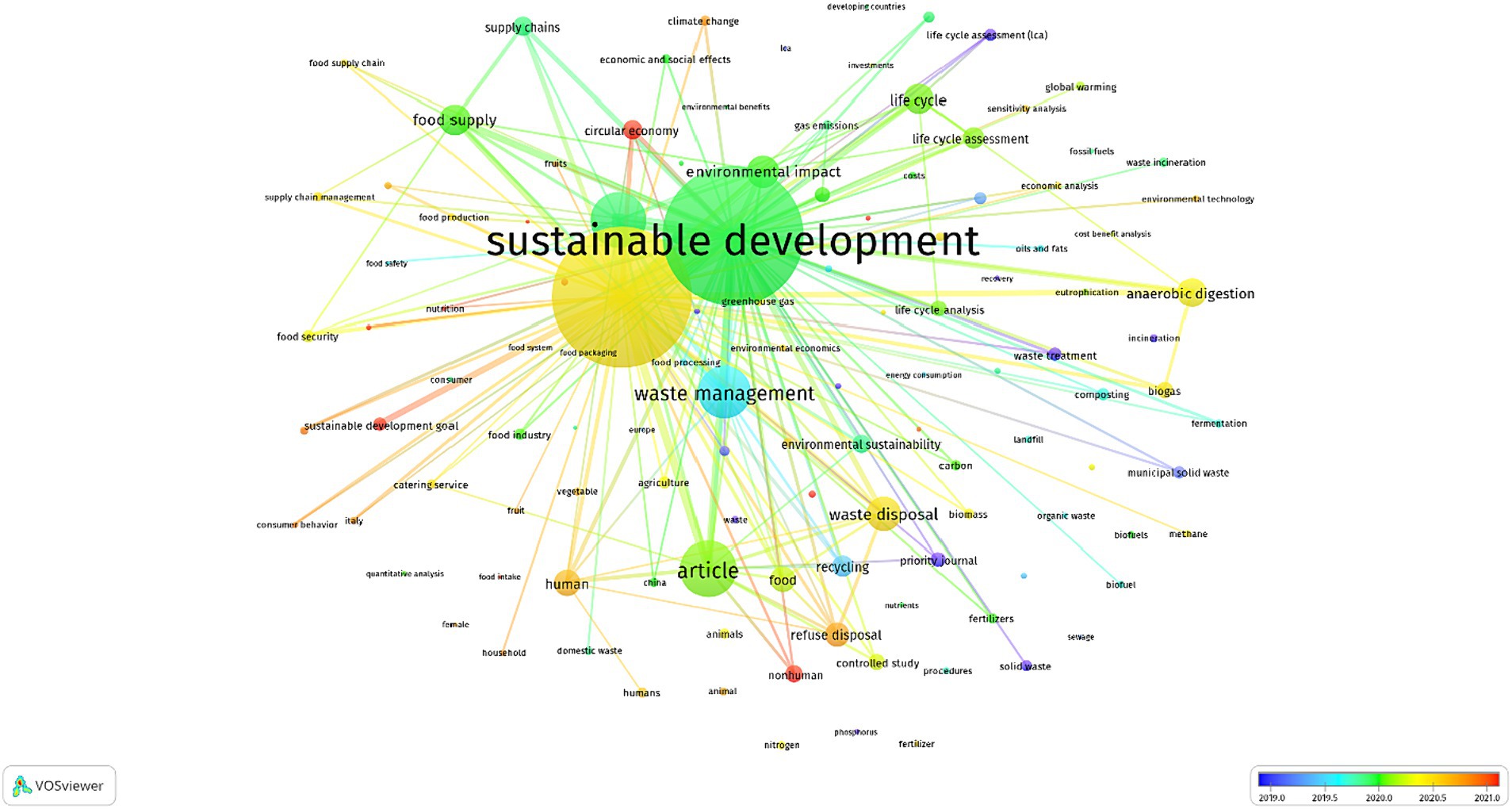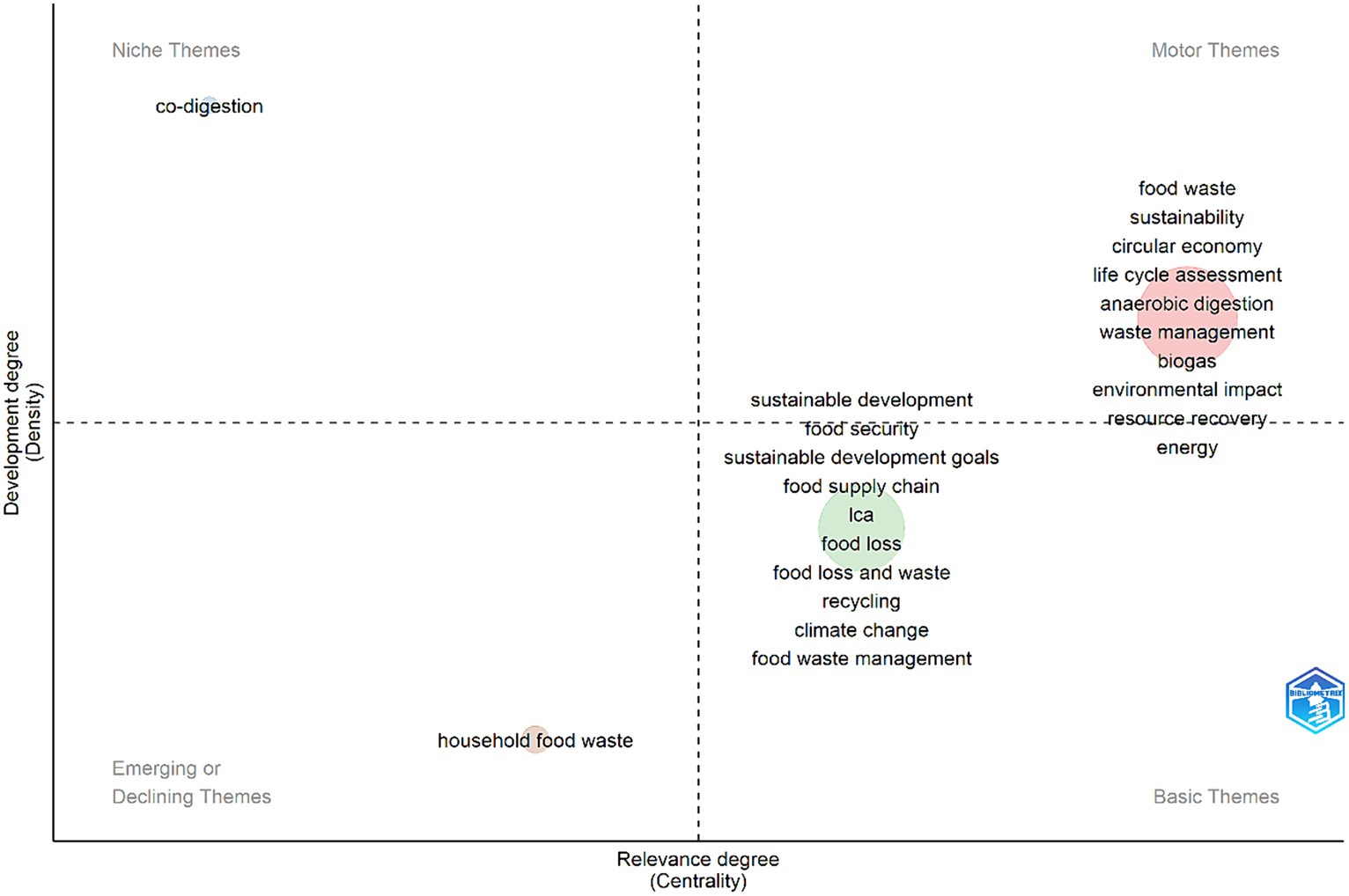- 1Department of Economics and Sustainable Development, School of Environment, Geography and Applied Economics, Harokopio University of Athens, Kallithea, Greece
- 2Department of Public and Community Health, University of West Attica, Athens, Greece
The present study investigates the relationship between food waste and sustainable development, aiming to reveal contextual insights and present novel findings regarding the pivotal importance of waste and environmental strategies toward a circular economy. This research represents an effort to delineate methodological and thematic contributions, thoroughly analyze key themes, examine co-citation patterns, assess collaboration among countries, and identify current knowledge gaps in the literature. As waste management takes precedence within the framework of sustainable development goals, policymakers, and academia will better understand how effective food waste management can contribute to environmental sustainability. Methodologically, we employ systematic review, employing the PRISMA approach, analyzing 761 final papers, and investigating the relationship between food waste and sustainable development. We delve deeper to reveal contextual insights and present empirical findings that underscore the critical role of food waste in the economy and environment. Furthermore, guided by the identified knowledge gaps, we illuminate potential future research avenues that hold immense promise for advancing our understanding of food waste and its impact on sustainable development.
1 Introduction
Sustainable Development Goals centered on food security, environmental preservation, and optimizing material and energy usage are significant motivators for effectively managing the overuse of food waste (Kaur et al., 2021). Food waste is a pressing global issue that squanders valuable resources and exacerbates challenges related to food security, environmental sustainability, and economic efficiency. Food waste, as defined by the Waste and Resources Action Programme,1 “is any food and inedible parts sent to a specified list of food waste destinations, where “food” is defined as any substance that was at some point intended for human consumption.”
A critical issue facing our global food system is the enormous amounts of food wasted yearly, leaving millions hungry. In order to resolve this contradiction, it is essential to comprehend the complex relationship between food waste and consumption patterns. This comprehensive investigation explores the different ways that consuming habits, from meal preparation and disposal to planning and purchasing, contribute to the creation of food waste. By looking at these relationships, we hope to pinpoint important intervention areas and create plans to encourage ethical and sustainable food consumption habits, ultimately reducing waste and guaranteeing everyone fair access to wholesome food. Approximately one-third of the food produced for human consumption goes to waste (Schanes et al., 2018). This phenomenon leads to several environmental issues, such as soil erosion, deforestation, water and air pollution, and the release of greenhouse gases during various stages of food production (Mourad, 2016). Thus, most developed countries have witnessed growing awareness and concern regarding the magnitude of food waste within their borders in recent years. Understanding food waste’s intricate parameters and dynamics becomes paramount as we strive to become more environmentally conscious and sustainable.
The current study broadly examines the available literature and discusses the interdisciplinary nature of food waste and its role in sustainable development (Buczacki et al., 2021). Our investigation seeks to unravel the main findings of the current research on sustainable development and SDGs. In doing so, we aim to shed light on the extent of the problem, the societal, economic, and environmental repercussions, and the potential strategies and interventions that can be adopted to mitigate food waste. The world, characterized by its cultural diversity, varying consumption patterns, and dynamic economies, presents a unique and complex landscape for studying food waste. Our investigation extends academic discussion on the association between food waste and sustainability.
More specifically, this study highlights the countries, the authors, and the sources that decidedly investigate the relationship between food waste and sustainable development. By analyzing the successes and challenges faced in the region, we aim to provide valuable insights that can underline possible scientific gaps, inform policy development, and encourage cross-border collaboration in the fight against food waste. In conclusion, this research contributes to the growing knowledge surrounding food waste. By examining the shape of food waste dynamics, we hope to provide food of thought for a foundation for evidence-based policies and practices to minimize food waste’s detrimental impact on society, the environment, and the economy. Pursuing a more sustainable and food-secure future for Europe necessitates a deeper understanding of food waste, making this study an essential step toward that goal.
In sum, the main contribution of this systematic literature review is twofold. Firstly, it serves as a tool for pinpointing areas where scholarly evidence remains insufficient, highlighting the need for further research to expand our understanding of food waste behavior. Secondly, it establishes a knowledge repository that can offer valuable insights for evidence-based decision-making and policy formulation. This, in turn, can enhance the quality and efficacy of policy measures and technological innovations to reduce food waste. However, several objectives and research questions should be addressed and responded to achieve these goals. The main objectives are as follows:
• To investigate the relationship between food waste and sustainable development through a bibliometric analysis.
• To identify key themes, trends, and knowledge gaps in the existing research on food waste and its connection to sustainability within the framework of a circular economy and
• To provide valuable insights for policymakers, academics, and stakeholders working toward reducing food waste and achieving sustainable development goals.
After that, the research questions that are necessary to be addressed and be able to achieve the objectives of the current research are as follows:
• RQ1: What are the dominant themes and research trends in the literature on food waste and sustainable development within a circular economy framework, as revealed by a bibliometric analysis?
• RQ2: What key methodological approaches are employed in the existing research on food waste and sustainable development?
• RQ3: What are the prominent countries, institutions, and authors contributing to the field, and how do they collaborate on research related to food waste and sustainable development?
• RQ4: What are the critical knowledge gaps and potential future research avenues identified in the current body of literature on food waste and sustainable development?
By addressing these research questions, this study aims to offer a comprehensive and data-driven understanding of the current knowledge surrounding food waste and its connection to achieving sustainable development within a circular economy. This understanding can inform future research efforts and guide the development of effective strategies to address this pressing global challenge.
The remaining components are organized as follows: Section 2 summarizes the research methodology and data selection. Section 3 delves into the empirical findings, exploring their connections to the article’s conceptual, intellectual, and social framework. Section 4 presents the conclusion and implications for policy.
2 Scheme of the research and empirical methodology
2.1 Bibliometric data
The bibliometrics approach assesses information trends to emphasize the contributions of both individuals and research groups. We also utilize review processes to synthesize content and generate innovative policy recommendations concerning the relationship between food waste and sustainable development. For the subsequent procedures, we exclusively rely on the Scopus database, which is recognized as one of the most reliable and comprehensive sources. We used “food waste” and “sustainable development” to pinpoint publications. After that, we eliminated non-relevant publications to exclude irrelevant studies (Shahbaz et al., 2021) following the PRISMA methodology (Page et al., 2021).
In particular, a comprehensive search string in Scopus combined relevant keywords related to food waste and sustainable development. The exclusion criteria were as follows: duplicates were removed, non-English language articles were excluded, and conference materials, editorials, and letters to maintain focus on in-depth research were also removed. Following data extraction using a standardized form, we employed a multifaceted approach. Bibliometric software like VOSviewer and bibliometrix facilitated co-citation analysis, keyword clustering, and citation network visualization are also employed. Additionally, text analysis techniques complemented our understanding of key themes and emerging trends within the selected publications. This process narrows our selection to a final set of 761 studies from 214 sources for further examination.
A compilation of 1,480 research publications published between 2003 and 2023 is the outcome of our first search. We chose this time frame with significant consideration for the reasons listed below. First, we want to highlight some recent developments. There has been much advancement in food waste and its relationship to sustainable development in recent years. With an emphasis on studies released after 2003, we sought to encompass the most recent findings and patterns in this quickly developing subject. Second, it is critical to comprehend the most recent research findings and their implications for current policy and practice as the urgency of tackling food waste and reaching sustainable development goals increases.
2.2 Bibliometric analysis
Researchers can use quantitative and qualitative methodologies to identify gaps in the scientific literature by using the bibliometrics methodology to track trends in academic research (Siddiqui et al., 2023). We have used bibliometric tools like VOSviewer, the R-package, and Biblioshiny to analyze publications about food waste (Aria and Cuccurullo, 2017). The VOSviewer is a tool that uses a two-dimensional map to show the relationships between co-citation data, geographic locations, research journals, and keywords. Their proximity shows the degree of link or similarity between nodes in this visualization. More specifically, this software is excellent at producing two-dimensional maps showing the connections between various items in a dataset. The most popular keywords and how they gathered together are shown in the visualization, which sheds light on the recurring themes in food waste. In addition, VOSviewer assists us in recognizing significant research and schools of thinking that have shaped our current comprehension of food waste and its relationship to sustainability.
On the other hand, R-package and Biblioshiny utilize a diverse set of bibliometric tools that serve as visualization functions for conducting information analysis and generating scientific maps related to the intersection of food waste and sustainability (da Silva Duarte et al., 2021; Srinivas, 2022). The package facilitates efficient data processing and transformation, ensuring the accuracy and consistency of the analysis. Biblioshiny provides advanced functions for constructing and analyzing bibliographic networks, allowing us to explore the intricate relationships between different entities within the food waste literature.
3 Empirical results
3.1 Publication output and citation growth
Figure 1 presents a per annum publication and citation growth trend since 2003, with an average of 75.6 citations per document. Notably, interdisciplinary research on food waste has received significant attention recently (Dhir et al., 2020). There has been an exponential increase in publications in recent years, with 2023 having the highest number of publications (146 articles).
Document-citation analysis was also performed using the “document” unit from the downloaded publications to create a table based on citation data by selecting the first ten documents as a threshold. For each of the ten documents, the number of citations and doi number are presented in the following Table 1. For brevity, most citations reported by Papargyropoulou et al. (2014) (910 citations) have investigated the factors that increase food waste through several channels of the food supply chain and propose a framework for appropriately managing food waste. Guo et al. (2010) (636 citations) focused their interest on agricultural production and the degradation of the natural environment due to the energy crisis. Authors propose hydrogen as one of the most promising substitutes for fossil fuels. After that, a group of authors with around 300 citations consists of Notarnicola et al. (2017), who has a total of 383 citations; Williams et al. (2012), with 360 citations, and Xue et al. (2017), who has 359 citations. Next, Alexander et al. (2017), Mourad, Garrone et al. (2014), Sharma P. et al. (2020), and Sharma S. et al. (2020) papers have more than 200 citations, but less than 300 completed the first ten high-cited documents.
3.2 Countries’ collaboration networks
Next, Figures 2, 3 visually represent global research collaboration among countries, displaying the collaboration network and the volume of publications contributed by each country.
In Figure 2, the research output is presented with varying shades of color, wherein the darker colors represent the regions with the highest frequency of publications. Notably, China is the global leader in research publications, with an impressive count of 481, showcasing its substantial contribution to the academic landscape. Following closely behind are other key players in the research arena, with Italy contributing 442 publications, the United Kingdom with 246, India with 215, and the United States with 208, all demonstrating their significant presence in the global research community. Additionally, several other highly productive economies, such as Spain, Sweden, Germany, Malaysia, and Australia, are notable contributors, further enriching the global research output landscape.
Moving on to Figure 3, it describes the collaborative aspect of research on a global scale, shedding light on the interconnections and partnerships between various countries in the pursuit of knowledge and academic advancement.
A compelling pattern emerges when examining collaborations between authors and countries in food waste. Notably, China, Italy, and the United Kingdom substantially collaborate. This outcome highlights their proactive stance in fostering international partnerships to tackle food waste and sustainability nexus. Following closely behind are the United States and Spain, both of which also participate actively in collaborative initiatives. These findings underscore the global significance of addressing food waste and the willingness of these nations to join forces in addressing this critical challenge.
3.3 Keywords, authors, and key countries framework
The upcoming section aims to reveal how researchers have documented various research streams across different countries. To achieve this, we employ the CAK framework to introduce innovative visualizations that portray the amalgamation of authors, research themes, and countries.
It is evident from Figure 4 that Italy, China, and the UK are the most prominent geographical locations. Likewise, the most dominant research themes are food waste, sustainable development, waste management, and waste disposal. It is worth noting that the smaller size of countries with limited contributions suggests that the current state of research is in its early stages. Additional research, mainly from European economies with substantial food demands, should shed light on recent research developments and explore new avenues of inquiry.
Figure 5, depicted as a tree diagram, visually represents the keywords extensively employed in the array of previously studied records. A closer examination of the results illuminates the prominent themes authors have chosen to emphasize in their works.
Notably, “food waste” takes the lead, featuring in approximately 36% of the articles. This underscores the paramount significance of addressing food waste within the scope of the research, signifying its pervasive relevance in current academic discourse. Sustainability is another crucial focus in 18% of the articles, highlighting the shared commitment to promoting sustainable practices and environmental responsibility within food waste management. Furthermore, the concept of a “circular economy” garners notable attention, being employed as a keyword in 10% of the publications, reflecting the growing interest in developing circular and resource-efficient systems to combat food waste. The utilization of “life cycle assessment” as a keyword in 8% of the articles underscores the methodological approach many authors took, emphasizing the importance of assessing environmental impacts across the entire life cycle of food products. Finally, the notion of “sustainable development” is reflected in 7% of the works, signifying the broader context in which food waste mitigation is situated, emphasizing the pursuit of development that satisfies current requirements without jeopardizing those of coming generations. This breakdown of prevalent keywords offers valuable insights into the thematic and methodological orientations of the scholarly discourse surrounding food waste. It underscores the critical areas of focus within this research domain.
3.4 Co-citation analysis of authors – intellectual structure
Afterward, we utilize co-citation analysis to understand better how literature has evolved in recent decades. The extent to which studies reference one another indicates the interrelatedness within the scientific literature. Co-citation analysis is a constantly changing metric that aids in recognizing emerging paradigms within a selected body of academic literature (Buczacki et al., 2021). In our present study, we refer to Figure 6 (co-citation analysis), where the number of citations is represented, and the relatedness of topics is indicated by the distance between these nodes, shedding light on academic discourse. The visualization in Figure 6 reveals two distinct clusters.
The first group of publications delves into the importance of food waste as a critical element in developing a sustainable food system (Quested et al., 2011). They also attempt to identify the losses occurring along the entire food chain and identify the causes of food losses and possible ways of preventing them (Quested et al., 2011; Falasconi et al., 2015; Eriksson et al., 2020). Conversely, a second cluster examines food issues in a more global scale analysis linked to sustainable development goals (Liu et al., 2022) introducing, for instance, the effects of international food trade on the food system (Wang et al., 2022). Smaller groups use a more quantitative analysis highlighting possible environmental and socio-economic impacts of food waste (Albizzati et al., 2021) and policies at a micro level (Lassen et al., 2019).
3.5 Conceptual structure of the publications
Recently, keyword co-occurrence networks have become increasingly popular in systematic review-based studies, offering a means to harness knowledge mapping and uncover associations among research themes in research management (Bashir et al., 2021). This approach empowers researchers to comprehensively understand a specific field within the amassed knowledge, harnessing the associations between keywords to reveal insights in economic literature. In our current research, we utilize a keyword co-occurrence network approach, setting a threshold of at least five occurrences for a word to be included. Consequently, out of a total of 1,136 keywords, 113 satisfied this requirement (see Figures 7, 8).
Notably, keywords like “food waste,” “sustainability,” “waste management,” “environmental impact,” and “waste disposable” are the most frequently occurring. Furthermore, as depicted in Figure 7, three separate groups of keywords are evident (green, red, and blue). Looking at the blue cluster, the keywords “sustainability,” “food supply,” “food security,” “nutrition” and “supply chain” exhibit close associations. As far as the red cluster is concerned, the keywords “article,” “waste disposal,” “fertilizer,” “biogas,” and “nitrogen” indicate a group of research that investigates the concept of food waste from a different perspective. An interesting observation is that keywords (green cluster) such as “life cycle assessment,” “gas emissions,” “anaerobic digestion,” “municipal waste,” and “climate change” have small node sizes but remain interconnected in terms of links.
After that, we expanded the keywords’ co-occurrence network by exploring its time evolution. The connection between food waste and sustainability is relatively recent, with most publications emerging after 2019. Even more recently, authors have also incorporated into their analysis the “circular economy,” “sustainable development goals,” “waste management,” and “food supply.” These keywords provide more information on the trend already in process around the relationship between food waste management and sustainability in the future. A notable trend is observed, with most publications centered around food waste, sustainability, environmental impact assessment, food supply, and climate change.
We further employ Figure 9 to explore thematic mapping from the perspective of four distinct subdivisions, which aids in comprehending the diversity and significance of sub-components within the scientific literature (Buczacki et al., 2021). We have established the maximum number of keywords at 119 and the minimum cluster frequency at 3.
The upper right section encompasses “motor themes,” representing research topics with the highest density and centrality, such as “food waste,” “sustainability,” “circular economy,” “life cycle assessment,” and “waste management.” In the lower-right quadrant, we find “food security” characterized by low density, discussing topics like “recycling,” “climate change,” “food waste management,” and “food supply chain.” These transversal themes hold significant importance in the research, contributing to discussions on various research directions. Lastly, “declining or emerging themes” and “niche themes” encompass research topics related to “household food waste” and “co-digestion.” In summary, Figure 9 serves as a valuable tool for understanding the current academic discourse and the potential role of food waste in future waste management policies.
4 Discussion
The present work aims to offer researchers and policymakers a toolbox of organized ideas to tackle food waste. Simultaneously, to achieve the objectives outlined in the Sustainable Development Goals, the target of reducing food waste and adopting a comprehensive strategy incorporating various measures is domineering. These efforts rectify informational gaps already highlighted by previous systematic literature review works (Schanes et al., 2018).
Besides, similar to previous studies (Principato et al., 2021) our research sheds light on the complex sides of the food waste phenomenon, highlighting the trend of research on this topic (Zhang et al., 2018; Vásquez Neyra et al., 2022; D'Adamo et al., 2023). More specifically, our study provides an essential segment of information presenting the issues around food waste that are denoted as the motor themes with a critical role of food waste in future food waste management and policies, such as the concept of circular economy (de Oliveira et al., 2021; Nikolaou and Tsagarakis, 2021; Santagata et al., 2021). In this direction, the European Food Safety Authority (2020) highlights that circular economy initiatives are increasing attention to food waste as a food and feed source.
Furthermore, our review, concentrating on strategies to reduce food waste and promote sustainability, dovetails with the Green Deal’s priorities, such as resource efficiency, waste reduction, and sustainable consumption. By positioning the study within the broader context of global sustainability challenges, it becomes evident that addressing food waste is integral to achieving the Green Deal’s ambitious targets. In this direction, according to FAO (2021) one of the ways toward more sustainable agriculture and food production is to manage food production systems sustainably through significant reductions in food loss and waste.
5 Concluding remarks and policy implications
The central objective of our research is to investigate the relationship between food waste and sustainability through a review of academic literature. Our study thoroughly examines all pertinent publications on the nexus between food waste and sustainable development. Given the pivotal role of food waste in the context of Sustainable Development Goals (SDGs), it becomes crucial for policymaking institutions to evaluate socio-economic and policy variables.
This evaluation is essential for harmonizing food consumption and environmental sustainability via several policy implications. For instance, policymakers should prioritize integrating food waste reduction strategies into the broader framework of SDGs. This approach ensures a more holistic and sustainable approach to addressing food waste while advancing the global sustainability agenda. Also, at a microeconomic level, governments must focus on socio-economic and policy factors that directly influence food waste. By designing policies that incentivize food waste reduction at the individual, household, and industrial levels, they can contribute to achieving both economic and environmental goals. On a more global-scale and macroeconomic level, collaboration among countries, mainly focusing on emerging economies, is essential to address the multifaceted challenges posed by food waste. Policymakers should explore international partnerships to facilitate knowledge sharing, best practices, and innovative strategies in mitigating food waste.
In a more specific and focused aspect, our analysis identifies key themes and research areas related to food waste and sustainability. European and national policy measures should emphasize the need to integrate specific food waste reduction strategies into national SDG goals such as Goal 2 (zero hunger) and Goal 12 (responsible consumption and production). Moreover, governments and policymakers can identify specific socio-economic and policy factors that significantly influence food waste at individual, household, and industrial levels. These policy interventions could include consumer awareness campaigns, incentivizing food waste reduction within entrepreneurs, exploring policies like tax breaks for businesses implementing waste reduction strategies, or introducing waste disposal fees based on waste generation. Financially, the public sector could also encourage policies that facilitate the redistribution of surplus food to those in need, reducing waste and promoting social welfare. That can be done by promoting the establishment of international funding mechanisms to support emerging economies in implementing effective food waste reduction strategies.
However, it is noteworthy that conducting country-specific analyses can offer valuable insights and potentially address limitations associated with quantitative data and analysis. Understanding the specific dynamics of food waste in different nations is crucial for tailoring effective policies and interventions. In addition, we urge future research to delve into the role of addressing food waste issues, particularly in emerging economies. Such research endeavors have the potential to yield diverse policy insights. By examining the unique challenges and opportunities food waste presents in these regions, policymakers can better understand the evolving issues in developing and developed nations. This knowledge is invaluable for shaping effective strategies to reduce food waste and promote sustainable practices worldwide.
Data availability statement
The raw data supporting the conclusions of this article will be made available by the authors, without undue reservation.
Author contributions
IK: Conceptualization, Investigation, Software, Visualization, Supervision, Visualization, Writing – original draft, Writing – review & editing. SP: Investigation, Software, Visualization, Writing – original draft, Writing – review & editing. GM: Investigation, Methodology, Software, Visualization, Writing – original draft, Writing – review & editing.
Funding
The author(s) declare that no financial support was received for the research, authorship, and/or publication of this article.
Conflict of interest
The authors declare that the research was conducted in the absence of any commercial or financial relationships that could be construed as a potential conflict of interest.
Publisher’s note
All claims expressed in this article are solely those of the authors and do not necessarily represent those of their affiliated organizations, or those of the publisher, the editors and the reviewers. Any product that may be evaluated in this article, or claim that may be made by its manufacturer, is not guaranteed or endorsed by the publisher.
Footnotes
References
Albizzati, P. F., Tonini, D., and Astrup, T. F. (2021). High-value products from food waste: an environmental and socio-economic assessment. Sci. Total Environ. 755:142466. doi: 10.1016/j.scitotenv.2020.142466
Alexander, P., Brown, C., Arneth, A., Finnigan, J., Moran, D., and Rounsevell, M. D. (2017). Losses, inefficiencies and waste in the global food system. Agric. Syst. 153, 190–200. doi: 10.1016/j.agsy.2017.01.014
Aria, M., and Cuccurullo, C. (2017). Bibliometrix: An R-tool for comprehensive science mapping analysis. Journal of Informetrics, 11, 959–975. doi: 10.1016/j.joi.2017.08.007
Bashir, M. F., Ma, B., Qin, Y., and Bashir, M. A. (2021). Evaluation of one belt one road publications: a bibliometric and literature review analysis. Environ. Sci. Pollut. Res. 28, 37016–37030. doi: 10.1007/s11356-021-14621-y
Buczacki, A., Gładysz, B., and Palmer, E. (2021). HoReCa food waste and sustainable development goals—a systemic view. Sustain. For. 13:5510. doi: 10.3390/su13105510
D'Adamo, I., Desideri, S., Gastaldi, M., and Tsagarakis, K. P. (2023). Sustainable food waste management in supermarkets. Sustain. Prod. Consum. 43, 204–216. doi: 10.1016/j.spc.2023.11.005
de Oliveira, M. M., Lago, A., and Dal’Magro, G. P. (2021). Food loss and waste in the context of the circular economy: a systematic review. J. Clean. Prod. 294:126284. doi: 10.1016/j.jclepro.2021.126284
da Silva Duarte, K. S., Lima, T. A. C., Alves, L. R., Rios, P. A. P., and Motta, W. H. (2021). The circular economy approach for reducing food waste: a systematic review. Revista Produção e desenvolvimento 7. doi: 10.32358/rpd.2021.v7.572
Dhir, A., Talwar, S., Kaur, P., and Malibari, A. (2020). Food waste in hospitality and food services: A systematic literature review and framework development approach. Journal of Cleaner Production, 270, 122861. doi: 10.1016/j.jclepro.2020.122861
Eriksson, M., Malefors, C., Bergström, P., Eriksson, E., and Persson Osowski, C. (2020). Quantities and quantification methodologies of food waste in Swedish hospitals. Sustain. For. 12:3116. doi: 10.3390/su12083116
European Food Safety AuthorityMaggiore, A., Afonso, A., Barrucci, F., and Sanctis, G. D. (2020). Climate change as a driver of emerging risks for food and feed safety, plant, animal health and nutritional quality. EFSA Support. Publ. 17:1881E. doi: 10.2903/sp.efsa.2020.EN-1881
Falasconi, L., Vittuari, M., Politano, A., and Segrè, A. (2015). Food waste in school catering: an Italian case study. Sustain. For. 7, 14745–14760. doi: 10.3390/su71114745
FAO. (2021) In Brief to The State of Food and Agriculture “Making agrifood systems more resilient to shocks and stresses.” Rome, FAO.
Garrone, P., Melacini, M., and Perego, A. (2014). Opening the black box of food waste reduction. Food Policy 46, 129–139. doi: 10.1016/j.foodpol.2014.03.014
Guo, X. M., Trably, E., Latrille, E., Carrère, H., and Steyer, J. (2010). Hydrogen production from agricultural waste by dark fermentation: a review. Int. J. Hydrog. Energy 35, 10660–10673. doi: 10.1016/j.ijhydene.2010.03.008
Kaur, G., Lasaridi, K., and Wong, J. (2021). “Sustainable food waste management: an introduction” in Current developments in biotechnology and bioengineering (Elsevier), 1–10.
Lassen, A. D., Christensen, L. M., Spooner, M. P., and Trolle, E. (2019). Characteristics of canteens at elementary schools, upper secondary schools and workplaces that comply with food service guidelines and have a greater focus on food waste. Int. J. Environ. Res. Public Health 16:1115. doi: 10.3390/ijerph16071115
Liu, Y., Tan, Q., Chen, J., Pan, T., Penuelas, J., Zhang, J., et al. (2022). Dietary transition determining the tradeoff between global food security and sustainable development goals varied in regions. Earth's Future 10:e2021EF002354 doi: 10.1029/2021EF002354
Mourad, M. (2016). Recycling, recovering and preventing “food waste”: competing solutions for food systems sustainability in the United States and France. J. Clean. Prod. 126, 461–477. doi: 10.1016/j.jclepro.2016.03.084
Nikolaou, I. E., and Tsagarakis, K. P. (2021). An introduction to circular economy and sustainability: some existing lessons and future directions. Sustain. Prod. Consum. 28, 600–609. doi: 10.1016/j.spc.2021.06.017
Notarnicola, B., Sala, S., Anton, A., McLaren, S. J., Saouter, E., and Sonesson, U. (2017). The role of life cycle assessment in supporting sustainable Agri-food systems: a review of the challenges. J. Clean. Prod. 140, 399–409. doi: 10.1016/j.jclepro.2016.06.071
Page, M. J., McKenzie, J. E., Bossuyt, P. M., Boutron, I., Hoffmann, T. C., Mulrow, C. D., et al. (2021). The PRISMA 2020 statement: An updated guideline for reporting systematic reviews. Journal of Clinical Epidemiology, 134, 178–89. https://www.ncbi.nlm.nih.gov/pubmed/33789819
Papargyropoulou, E., Lozano, R., Steinberger, J. K., Wright, N., and bin Ujang, Z. (2014). The food waste hierarchy as a framework for the management of food surplus and food waste. J. Clean. Prod. 76, 106–115. doi: 10.1016/j.jclepro.2014.04.020
Principato, L., Mattia, G., Di Leo, A., and Pratesi, C. A. (2021). The household wasteful behaviour framework: a systematic review of consumer food waste. Ind. Mark. Manag. 93, 641–649. doi: 10.1016/j.indmarman.2020.07.010
Quested, T. E., Parry, A. D., Easteal, S., and Swannell, R. (2011). Food and drink waste from households in the UK, vol. 36, 460–467.
Santagata, R., Ripa, M., Genovese, A., and Ulgiati, S. (2021). Food waste recovery pathways: challenges and opportunities for an emerging bio-based circular economy. A systematic review and an assessment. J. Clean. Prod. 286:125490 doi: 10.1016/j.jclepro.2020.125490
Schanes, K., Dobernig, K., and Gözet, B. (2018). Food waste matters-a systematic review of household food waste practices and their policy implications. J. Clean. Prod. 182, 978–991. doi: 10.1016/j.jclepro.2018.02.030
Siddiqui, A., Altekar, S., Kautish, P., Fulzele, S., Kulkarni, N., Siddiqui, M., et al. (2023). Review of measurement of sustainable development goals: A comprehensive bibliometric and visualized analysis. Environmental Science and Pollution Research, 30, 91761–91779. doi: 10.1007/s11356-023-28887-x
Shahbaz, M., Bashir, M. F., Bashir, M. A., and Shahzad, L. (2021). A bibliometric analysis and systematic literature review of tourism-environmental degradation nexus. Environ. Sci. Pollut. Res. 28, 58241–58257. doi: 10.1007/s11356-021-14798-2
Sharma, S., Basu, S., Shetti, N. P., and Aminabhavi, T. M. (2020). Waste-to-energy nexus for circular economy and environmental protection: recent trends in hydrogen energy. Sci. Total Environ. 713:136633. doi: 10.1016/j.scitotenv.2020.136633
Sharma, P., Gaur, V. K., Kim, S., and Pandey, A. (2020). Microbial strategies for bio-transforming food waste into resources. Bioresour. Technol. 299:122580. doi: 10.1016/j.biortech.2019.122580
Srinivas, H. (2022). “Nexus in green economics for Asian countries” in Progress in green economics, 1–16.
Vásquez Neyra, J. M., Cequea, M. M., Gomes Haensel Schmitt, V., and Ferasso, M. (2022). Food consumption and food waste behaviour in households in the context of the COVID-19 pandemic. Br. Food J. 124, 4477–4495. doi: 10.1108/BFJ-07-2021-0798
Wang, J. M., Liu, Q., Hou, Y., Qin, W., Bai, Z. H., Zhang, F. S., et al. (2022). Impacts of international food and feed trade on nitrogen balances and nitrogen use efficiencies of food systems. Sci. Total Environ. 838:156151. doi: 10.1016/j.scitotenv.2022.156151
Williams, H., Wikström, F., Otterbring, T., Löfgren, M., and Gustafsson, A. (2012). Reasons for household food waste with special attention to packaging. J. Clean. Prod. 24, 141–148. doi: 10.1016/j.jclepro.2011.11.044
Xue, L., Liu, G., Parfitt, J., Liu, X., Van Herpen, E., Stenmarck, Å., et al. (2017). Missing food, missing data? A critical review of global food losses and food waste data. Environ. Sci. Technol. 51, 6618–6633. doi: 10.1021/acs.est.7b00401
Keywords: food waste, sustainability, behavior, bibliometric analysis, VOSviewer, bibliometrix
Citation: Kostakis I, Papadaki S and Malindretos G (2024) Analyzing the relationship between consumers’ and entrepreneurs’ food waste and sustainable development using a bibliometric approach. Front. Sustain. 5:1373802. doi: 10.3389/frsus.2024.1373802
Edited by:
Om Prakash Narayan, University of Florida, United StatesReviewed by:
Poonam Khatri, Fort Valley State University, United StatesEnrica Vesce, University of Turin, Italy
Michael Martin, Swedish Environmental Research Institute (IVL), Sweden
Copyright © 2024 Kostakis, Papadaki and Malindretos. This is an open-access article distributed under the terms of the Creative Commons Attribution License (CC BY). The use, distribution or reproduction in other forums is permitted, provided the original author(s) and the copyright owner(s) are credited and that the original publication in this journal is cited, in accordance with accepted academic practice. No use, distribution or reproduction is permitted which does not comply with these terms.
*Correspondence: Ioannis Kostakis, aWtvc3Rha2lzQGh1YS5ncg==
 Ioannis Kostakis
Ioannis Kostakis Stamatina Papadaki
Stamatina Papadaki George Malindretos
George Malindretos